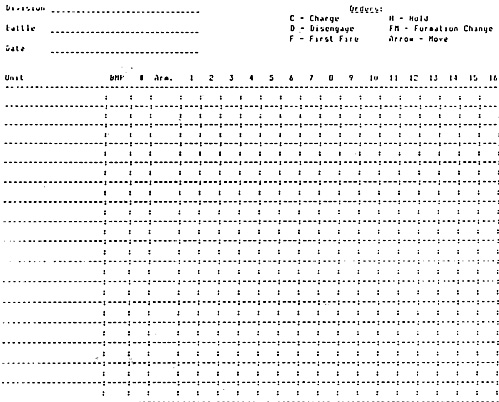A natural tendency of wargame players as they become more familiar with a rules system is to increase the size of the scenarios they play. Let's face it, after two years of playing Johnny Reb, it's hard to find much of a challenge in the Pitzer's Run scenario. Unfortunately, as the size of the scenario grows, so also do the problems of managing one's forces, that is, keeping track of Base Morale Point, armament, orders, etc. It is when playing large-scale scenarios that the limitations of the chit system of marking orders make themselves known. These problems include:
- 1. The tendency for confusion to arise when units
become crowded into a small area. It can be difficult to tell
which chit is intended for which unit, to the point where
even the player in command of the troops can loose track;
2. They get lost. Particularly in scenarios that include a lot of woods (which most Civil war battlefields do) the olive green color of the chits tends to blend with the terrain. Even after careful searches, I'm sure there are sill chits mixed with my lichen;
3. A corollary of (2) avoid is that there are never enough chits. This situation arises frequently when there are more players than copies of the rules. Loosing chits only makes the situation worse;
4. They clutter the table, which can drive clean battlefield aficionados like myself to distraction.
All of the above factors contributed to our group going to written orders. as an aid to placability, I came up with an orders sheet for Johnny Reb (although is has been used successfully with other games).
The sheet provides a line for each regiment (or artillery section), with space for unit designation, base Morale Point, size (the "#" column), and type of armament (the I I arm." column). Space is provided to mark orders for 20 turns. If a scenario is longer than 20 turns, use two lines per unit. A list of standard order abbreviations is provided at the top for the benefit of new players (who always seem to be in the majority).
Movement orders are designated with an arrow. The arrow is drawn in he direction of the movement relative to the unit's current facing. On the order sheet, the unit is assumed to be facing the top of the page. Thus, an arrow pointing to the top of the page denotes that the unit is moving straight ahead.
Enclosed is an example of how a sheet is used. Note that all the important information about the brigade is listed. The vital statistics for the brigade and division commanders (morale effect, function effect, number of orders that can be given) are also shown. In this example, Gregg's entire brigade moves forward on turn 1. Four of the regiments change formation (deploy from column to line) on turn 2, while the artillery slants to take position on the right (note the arrows at 45 degree angles to the right).
When playing large scenarios with which many of the players are unfamiliar, it is useful for the person setting up the scenario to fill these sheets out in advance, to be given to players before the game. This allows them to become familiar with their commands before play begins. If a unit does not enter until a given turn, block out the order boxes for those turns during which the unit is not present. This ensures that units entering late begin marking on the same turn as other units already in the game.
When using written orders, we have found it easiest if unit actions are not declared until the phase in which they will be carried out. Thus, after the Routs and Rallies phase, all units that are first firing announce their intentions, and fire is resolved. Then charges (and units going to Conditional Hold) are declared and resolved, etc. Since unit intentions are not clearly marked onto he table, a certain amount of trust is involved in playing this way. Players must either trust one another, make provisions for verifying questionable actions, or have an impartial judge to check marked orders and immediate accusations of impropriety. As a recent retiree was fond of saying, "trust but verify."
Please feel free to make copies of the sheet provided in this issue. Let me know if you feel it is worthwhile, or if you find any improvements that could be made. Hopefully it will make book-keeping a little easier, and allow more of your time and effort to go into beating the other guy.

Back to The Zouave Vol VI No. 3 Table of Contents
Back to The Zouave List of Issues
Back to Master Magazine List
© Copyright 1992 The American Civil War Society
This article appears in MagWeb (Magazine Web) on the Internet World Wide Web.
Other military history articles and gaming articles are available at http://www.magweb.com